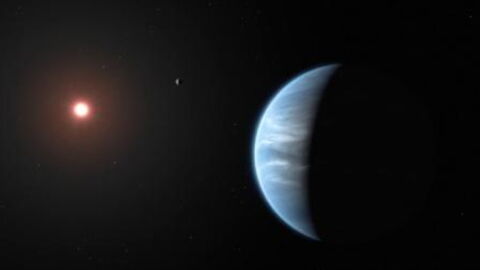A study of the images provided by Hubble has made it possible to distinguish volcanic activity on this planet, named GJ 1132 b and located 41 light-years from our solar system. This is the first time that a secondary atmosphere has been detected on a planet outside the solar system.
Discover our latest podcast
‘We first thought that these highly radiated planets would be pretty boring because we believed that they lost their atmospheres,’ said Raissa Estrella, co-author of the study at NASA's Jet Propulsion Laboratory in Pasadena, California, in a science release published by NASA and ESA, the European Space Agency. ‘This is exciting, because we think the atmosphere we see today has been regenerated.’
Vision through spectroscopy
A combination of direct observations and computer modelling have established that this secondary atmosphere consists of hydrogen, hydrogen cyanide, methane, ammonia, and a hydrocarbon haze, whereas the primary atmosphere of GJ 1132 b would have consisted of hydrogen and helium.
The astronomers' studies suggest that the initial hydrogen may have been 'absorbed' by the exoplanet's molten magma mantle. It was then released by volcanic activity, forming this new atmosphere. The scientific team hypothesises that the crust of GJ 1132 b is very thin and too fragile to support any volcanic mountain-like terrain. The flat terrain could be cracked, like an eggshell, which could explain the release of hydrogen and other gases.
‘This discovery is important because it gives scientists working on exoplanets a way to better understand the geology of a planet from its atmosphere,’ explains Paul Rimmer, from the University of Cambridge in the release. ‘This secondary atmosphere comes from both the surface and the interior of the planet, so it's a window into the geology of another world,’ Rimmer continued.
There is still a lot of work to be done to properly look through it, but the discovery of this window is of great importance.
An eerie similarity
When astronomers use the future James Webb Space Telescope to study GJ 1132 b, it is possible that they will be able to observe ‘not the spectrum of the atmosphere, but rather the spectrum of the surface’ and thus real geological activity, points out Mark Swain, team leader at the Jet Propulsion Laboratory.
GJ1132 b and the Earth share some common features: both have similar density, size, and age and are thought to have had an atmosphere that was largely hydrogen at the beginning and was heated before cooling. Studies by astronomers suggest that they may have the same atmospheric pressure at their surfaces.
Check out the video above to learn more about exoplanets.















